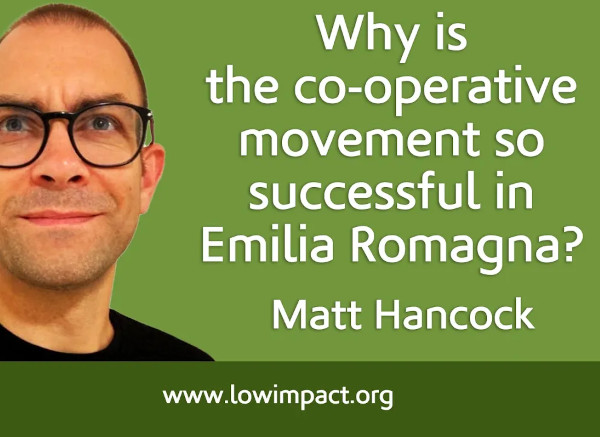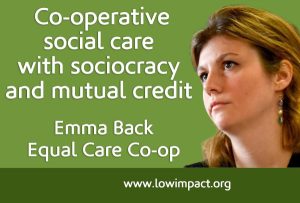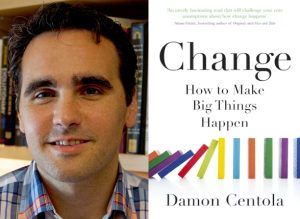Today I’m talking with Matt Hancock, who’s been heavily involved with the co-operative movement in Emilia Romagna – the region of Italy around Bologna. There’s a huge, very successful co-op sector in ER. I want to try to find out in this interview is why – what’s special about ER, and can it be emulated elsewhere?
Here’s a summary of our conversation. The full interview can be seen in the video below.
About Matt
Yes, Matt knows about the UK politician Matt Hancock. No similarities in philosophy, thankfully.
He got into co-ops by accident. In the early 2000s he was a student activist around environmental issues and trying to get corporate money out of the political system. He was trying to work out what he was for, as well as what he was against; and he was very interested in and attracted to all things Italian.
He moved to Bologna and was fascinated by the booming co-operative sector there – the ‘Emilian Model’. He studied co-operative economics with Professor Stefano Zamagni at the University of Bologna (the oldest university in the world), and worked at the Institute for Labour. There’s a lot of high-tech industry in ER, with lots of small and medium-sized firms in collaborative networks. He studied innovation and worker participation within these firms. He’s also done development work with employee-owned companies in the US.
About Emilia Romagna
His go-to book about The Emilia Model is The Second Industrial Divide by Piore and Sabel of MIT. The Emilia Model started to be studied in the 1970s and 80s, when traditional industry in Europe was in trouble, and people were looking for alternatives (like the Toyota Model and lean production). Businesses in ER tend to be very small, and started by skilled workers. There’s a high level of collaboration / networking between them. Part of the reason is that this is a characteristic of the Italian economy. In ER, firms are not just small, but agile too. If a firm gets too big, skilled workers often decide to set up on their own, rather than work for someone else. So businesses don’t get too top-heavy, and there’s a lot of diversification and specialisation. Instead of the usual economy of scale, in ER there is what they call and economy of scope.
There aren’t that many sources of big capital – in ER and Italy generally, and giant industries can only survive with massive state support. This is partly due to the way capitalism developed in Italy – without a strong bourgeoisie, and partly due to the education of skilled workers, who ‘spin-off’ and start small, specialised businesses. There’s a cultural / historical element and it’s partly down to necessity. The move to cities / factories from agriculture happened later (post WW2) in Italy. Farms got bigger, as did cities and industry. The new farmers needed tractors and agricultural equipment, that were produced locally. Lamborghini made tractors before they made sports cars. There was a demand for high-tech products and a huge number of small firms with skilled workers. They couldn’t compete with mass production, but they had an advantage because they were nimble, small, networked and highly-skilled.
History of co-operation in Emilia Romagna
In a region of 5 million people, there are 4000 co-operative businesses, that employ 250,000 people – just under a quarter of the entire workforce. The co-op movement in ER goes back to the mid 19th century, with roots in the workers’ mutual aid societies, and many of the early ones are still strong today. It wasn’t a reaction to capitalism. The co-op movement developed alongside capitalism.
There’s an entrepreneurial spirit, but also a propensity to do things together – creating associations, unions, co-ops, credit unions etc. There’s joint purchasing and lobbying, collective bargaining etc. There’s a sense that ‘we have to solve problems together’ rather than as individuals. He’s noticed that the culture / economy is very innovative, but one of the least competitive. At the individual level, there’s not the sense of competition that exists in the Anglo-Saxon world, and certainly not in the US. It’s cultural and deep-rooted. The origins can’t be replicated, but the practices can. The legislation and support for the co-op sector followed long after the practices.
In the US, for example, people who want to emulate their co-operative success look to replicating the legislation or support, but the co-operative practices happened much earlier. It was just that people rolled their sleeves up and said ‘let’s do this, together’ – to benefit ourselves, our communities and future generations. That’s the attitude that has to be fostered first, rather than legislation / support.
ER is now has the most productive agricultural sector in Italy. That wasn’t the case 100 years ago, when it was largely marsh / wetlands. The municipalities employed co-ops to drain the land.
In Italy and ER, if a firm falls into crisis, there’s more of a tendency for workers to try to fix the problem, rather than leave. The municipalities work with those workers to either find another buyer or to help them convert to a co-op. Banks provide finance specifically to do that, and the co-op movement (in Italy, not just ER), taxes itself (3% of the profits of every co-op in Italy!) for an investment fund to help struggling firms convert.
Citizens’ response to climate change is not to wait for government or big business to do something, but to set up co-ops installing solar, for example. The first electric car charging stations in Italy were produced by groups of people in ER who didn’t want to drive internal combustion engine vehicles any more, so set up a co-op to create a network of charging stations.
Co-ops in ER today
There are 3 million co-op members in ER (in a total population of 5 million!). So the co-op sector is huge – although there is some concern that the number of startups isn’t what it used to be. People typically shop at co-ops, bank with co-ops, receive health and social care from co-ops, farmers form co-ops, manufacturers form co-ops. So although the sector is huge, there’s a concern that the younger generation may be seduced by the Silicon Valley startup model.
When it comes to starting co-ops, Italian law allows you to take future unemployment benefits and invest them up-front in starting a co-op. There are 3 co-operative development funds (funded by the 3% self-imposed tax), that make loans to new co-ops, or put in some ‘patient capital’. These funds and co-operative associations are administered by groups from all political groups, from communist to Christian Democrat. Belief in the co-operative movement exists all across the political spectrum (even fascists have started co-ops, although in the 1920s and 30s attacked the co-op movement, burning down their offices and killing and maiming co-operators).
So funds for developing co-ops are largely owned and administered by the co-op movement itself. There’s also an expectation that individuals will put their own money into starting up a co-op. Co-ops also purchase and absorb existing private businesses, either directly or via a holding company. Co-ops leverage the capitalist system to do this in various ways – such as becoming majority shareholders in private firms, or majority shareholders in investment funds that own private firms.
Although this kind of connection with capitalism means there’s a danger of extraction of wealth from the region to pay shareholders, the attitude is practical, but that everything that happens needs to bolster the co-operative movement, not drain it for the benefit of private investors. Co-ops have mastered the tools of private equity, but to the benefit of co-ops. They always ensure that they don’t do anything that will result in their losing control, from a governance perspective. From a governance perspective, private capital is subordinate. Ensuring control while leveraging finance is a big risk and a fine balancing act that they seem to have got right. There’s not a major risk of demutualisation and absorbtion into the corporate world (as happened with the Co-op Bank, Co-op Energy and most building societies in the UK, and Savings & Loan companies in the US). Asset locks are in place so that any income from demutualisation and sale goes to the co-op movement, not to individual members. Co-ops tend to avoid this risk by creating holding companies or wholly-owned subsidiaries that become the vehicles for raising private capital.
Life in Emilia Romagna now
The economy is stronger and unemployment is lower than the rest of Italy in ER. There’s a very strong co-operative sector that’s part of a unique social partnership model of governance. Decisions get made co-operatively between workers’ organisations, the municipalities, the regional government, co-operative associations and other employer associations. In 2015 they signed ‘The Pact for the Economy and Labour’, after a long period of joint negotiation around priorities. They really do co-operate. The discussions now also include de-carbonising the economy.
We talked about the modern welfare state as a response to the deficiencies of capitalism, and how there are inevitably problems with such a huge, centralised system. We can build community-based, self-help and co-operative / commons initiatives to provide services / safety nets that are owned by communities themselves. The struggle is how to get that right. The position of the co-op movement in ER is not to try to get rid of the state, but to work out its role. Part of its role is direct funding of community-based services – although it may not directly provide them. There are discussions happening about the role of the state / public sector, the non-profit sector and the co-operative sector. The general idea is that the state should provide healthcare, but in a subsidiarity mindset. There’s not a big move to co-operativise hospitals etc. It also has a role of guaranteeing services, regardless of who provides them.
Matt also talked about discussions happening about forming social care co-ops in which members are not just workers but also people receiving the care. This is something the Equal Care Co-op are exploring in the UK. See our interview with them here. Many services provided by the municipalities are being contracted out to social co-operatives (without breaching EU trade liberalisation rules). More and more social care is being provided by social co-ops, remaining small and in touch with the people they serve. Adequate funding has to be provided though, otherwise services will be expanding / developing on the backs of the people doing the work.
After 2008, the region fared better than the rest of Italy, and recovered more quickly. Co-ops are very important in that respect. They’re less likely to lay off people in a crisis etc. However, the co-operative construction industry was completely decimated, and hasn’t recovered. The crisis did rock some other established co-ops too. The ones that did well were the ones with strong internal democracy (therefore less entrenched in their ways), and more diversity of trading partners, especially international ones.
The founders of the ER co-ops in the 19th century had a common problem – creating employment and feeding and provisioning themselves. They decided to work out their common problem ‘in common’ – even if it meant making sacrifices. The supportive laws and institutions came later, once the movement had started to provide those jobs and provisioning, and the various associations, municipalities and regional government could see that it worked. There’s no reason that this can’t be emulated elsewhere if the will is there. Co-operation is entrepreneurial – i.e. not waiting for other people to solve our problems, but getting together with like-minded people and rolling our sleeves up.
In many parts of the world, people are waking up to the looming environmental crisis, and wanting governments and other institutions to do something about it. In ER, the co-op movement got together with local institutions and municipalities and decided to do it themselves, via the Pact for the Economy, Labour and Climate’.
Interesting sources of information:
About the Emilia-Romagna economy in general:
- https://www.investinemiliaromagna.eu/
- https://base.socioeco.org/docs/emilia_romagna_by_david_thompson_110604.pdf
By Matt:
- https://www.socioeco.org/bdf_fiche-document-690_en.html
- https://institute.coop/resources/communist-party-land-cooperation
- https://www.smu.ca/webfiles/WorkingPaper2020-01.pdf
His book, Compete to Co-operate:
Interview with Vera Negri:
https://thenextsystem.org/learning-from-emilia-romagna
Highlights
- In ER, firms are not just small, but agile too. If a firm gets too big, skilled workers often decide to set up on their own, rather than work for someone else.
- In a region of 5 million people, there are 4000 co-operative businesses, that employ 250,000 people – just under a quarter of the entire workforce.
- There’s not the sense of competition that exists in the Anglo-Saxon world, and certainly not in the US. It’s cultural and deep-rooted. The origins can’t be replicated, but the practices can. The legislation and support for the co-op sector followed long after the practices.
- The economy is stronger and unemployment is lower than the rest of Italy in ER. There’s a very strong co-operative sector that’s part of a unique social partnership model of governance. Decisions get made co-operatively between workers’ organisations, the municipalities, the regional government, co-operative associations and other employer associations.








7 Comments
I would really appreciate some help on how to form a start-up as a ‘commons businesses’. You elude to this at 53 minutes when you refer to outsourcing to coops, ‘or the commons eventually’. What does that mean? Is it a social cooperative as highlighted by Matt?. Is it something that has yet to be done? If so, let’s design it with the end in mind.
31.20 is also interesting. ‘how do they share risk & rewards’. To my mind, these are very capitalist questions that indicate that in the final analysis the cooperative sector is still only a variation on a theme.
I’m thinking an unincorporated private members coop. I don’t want anything to do with the Financial Conduct Authority, or Coop UK who are ultimately about making sure coops are acceptable to the dominant financial system.
I would really appreciate some help on how to form a start-up as a ‘commons businesses’. You elude to this at 53 minutes when you refer to outsourcing to coops, ‘or the commons eventually’. What does that mean? Is it a social cooperative as highlighted by Matt?. Is it something that has yet to be done? If so, let’s design it with the end in mind.
31.20 is also interesting. ‘how do they share risk & rewards’. To my mind, these are very capitalist questions that indicate that in the final analysis the cooperative sector is still only a variation on a theme.
I’m thinking an unincorporated private members coop. I don’t want anything to do with the Financial Conduct Authority, or Coop UK who are ultimately about making sure coops are acceptable to the dominant financial system.
Hi Simon. I’ll give this a go, and try to get others to answer too.
IMO, commons is about ownership. We can’t ‘common’ things if we don’t own them. In traditional societies, there wasn’t any legal form of ownership – things (forests, lakes etc.) weren’t owned by any entity – just by the community as a whole, and the community (or the elders) made rules about how they were to be used, to prevent overuse.
But today, we can’t common things that are owned privately or by the state. So we have to form some sort of entity to legally own the resources before they can be commoned. I know we’ve talked about setting up multi-stakeholder co-ops as ‘housing commons’ institutions; and the new commons ideas being developed are a way to raise the finance to bring infrastructure and resources into common ownership – via those co-ops. Chris Cook’s idea is called ‘Nondominium’ – not a co-op, or any kind of incorporated entity at all – just legal agreements between members.
I don’t think ‘risk and reward’ have to be capitalist concepts. If we take housing commons as an example, we have to raise the funds to buy the houses in the first place, which is a risk. These new ideas will mean that the risks are shared amongst the community, and if successful (and I don’t see why they shouldn’t be, as they don’t require debt or interest), then the rewards will accrue to the community too – in the form of affordable, good-quality housing with secure tenure (rather than profits for capitalists, interest for bankers / mortgage providers or rent for private landlords) (god, that sounds like such a medieval term, doesn’t it?)
Hi Simon!
Elinor Östrom’s study of Commons suggests it is important not to consider state recognition as important, so I guess you’ll be happy about that.
At the same time, she made it very clear that Commons Governance – the agreements that exist between Commoners – are important.
David Bollier and Silke Helfrich, from their long consideration of how Commons can flourish, suggest that the social aspect of agreements – which will likely mostly be unwritten – are the most important.
From these, we can probably guess that the legal form of a ‘commons business’ is mostly to be chosen on the basis of avoiding negative implications, rather than expecting it to provide positives.
If the social relations of the Commoners are strong and consciously about commoning, then the legal form is probably of little importance. What will matter is that it doesn’t get in the way of commons management, or render the commons vulnerable to subversion. There is certainly careful work to be done here.
On the other hand, a carefully designed legal framework won’t be of much use if the social fabric of the Commons breaks down.
Practically, CLG constitutions seem to offer design freedoms. Chris Cook is increasingly keen on a little known, but UK recognised legal form called an ‘Unlimited Company’. Private membership organisations can be fine, but I don’t believe businesses can be members – only people.
I agree with Dave about ‘risk and reward’. We can’t allow normal concepts like this to be ‘owned’ by their capitalist interpretations. We all know what both words mean in all sorts of contexts where there is no number attached – let alone a money number.
Emilia-Romagna has a rather high labour participation rate. Surely 250,000 souls are not one quarter of the working population. A typo perhaps? Would be great to see more accurate figures here. I very much enjoyed the article otherwise.
Alan – population of Emilia-Romagna, c 4 million. Take off retirees, unemployed and young people/children, and a working population of around 1 million would seem to be a reasonable-ish figure, which would make 250k a quarter of that. So the right ballpark at least, I think.
Matt: your earphones look very much like upscale Ham gear. Just sayin, sir.